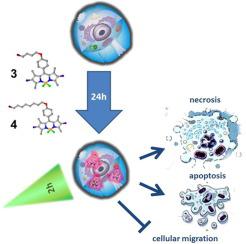Bioorganic & Medicinal Chemistry ( IF 3.5 ) Pub Date : 2020-08-29 , DOI: 10.1016/j.bmc.2020.115737 Enrico Caruso 1 , Miryam C Malacarne 1 , Emanuela Marras 1 , Ester Papa 2 , Linda Bertato 2 , Stefano Banfi 1 , Marzia B Gariboldi 1

|
A new class of compounds based on the 4,4-difluoro-4-bora-3a,4a-diaza-s-indacene core, known as BODIPYs, has attracted significant attention as photosensitizers suitable for application in photodynamic therapy (PDT), which is a minimally invasive procedure to treat cancer. In PDT the combination of a photosensitizer (PS), light, and oxygen leads to a series of photochemical reactions generating reactive oxygen species (ROS) exerting cytotoxic action on tumor cells.
Here we present the synthesis and the study of the in vitro photodynamic effects of two BODIPYs which differ in the structure of the substituent placed on the meso (or 8) position of the dipyrrolylmethenic nucleus. The two compounds were tested on three human cancer cell lines of different origin and degree of malignancy.
Our results indicate that the BODIPYs are very effective in reducing the growth/viability of HCT116, SKOV3 and MCF7 cells when irradiated with a green LED source, whereas they are practically devoid of activity in the dark. Phototoxicity occurs mainly through apoptotic cell death, however necrotic cell death also seems to play a role. Furthermore, singlet oxygen generation and induction of the increase of reactive oxygen species also appear to be involved in the photodynamic effect of the BODIPYs. Finally, it is worth noting that the two BODIPYs are also able to exert anti-migratory activity.
中文翻译:

用于光动力疗法(PDT)的新BODIPY:人类癌细胞系的合成和活性
基于4,4-二氟-4-硼-3a,4a-二氮杂-s-茚并四烯核的一类新型化合物,即BODIPYs,作为适用于光动力疗法(PDT)的光敏剂而引起了广泛关注。是治疗癌症的微创手术。在PDT中,光敏剂(PS),光和氧气的组合会导致一系列光化学反应,从而产生活性氧(ROS),从而对肿瘤细胞产生细胞毒作用。
在这里,我们介绍了两个BODIPY的合成和体外光动力效应的研究,这两个BODIPY的取代基结构不同,该取代基位于二吡咯烷基亚甲基核的内消旋(或8)位置。对这两种化合物在三种起源和恶性程度不同的人类癌细胞系中进行了测试。
我们的结果表明,当用绿色LED光源照射时,BODIPYs在降低HCT116,SKOV3和MCF7细胞的生长/存活力方面非常有效,而实际上它们在黑暗中没有活性。光毒性主要通过凋亡细胞死亡发生,但是坏死细胞死亡似乎也起作用。此外,单线态氧的产生和活性氧种类的增加的诱导似乎也与BODIPY的光动力效应有关。最后,值得注意的是,两个BODIPY也能够发挥反移民活动。


























 京公网安备 11010802027423号
京公网安备 11010802027423号